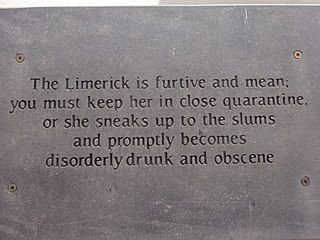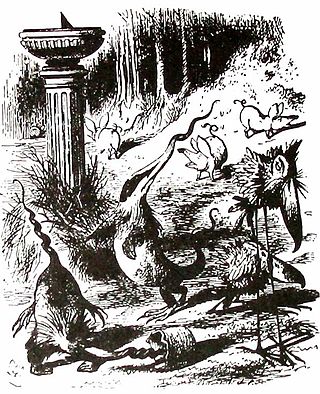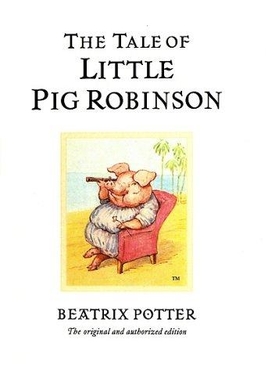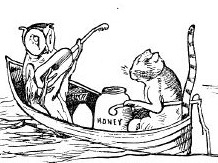
Helen Beatrix Potter was an English writer, illustrator, natural scientist, and conservationist. She is best known for her children's books featuring animals, such as The Tale of Peter Rabbit, which was her first commercially published work in 1902. Her books, including 23 Tales, have sold more than 250 million copies. An entrepreneur, Potter was a pioneer of character merchandising. In 1903, Peter Rabbit was the first fictional character to be made into a patented stuffed toy, making him the oldest licensed character.

Edward Lear was an English artist, illustrator, musician, author and poet, who is known mostly for his literary nonsense in poetry and prose and especially his limericks, a form he popularised.

A limerick is a form of verse that appeared in England in the early years of the 18th century. In combination with a refrain, it forms a limerick song, a traditional humorous drinking song often with obscene verses. It is written in five-line, predominantly and amphibrach trimeter with a strict rhyme scheme of AABBA, in which the first, second and fifth line rhyme, while the third and fourth lines are shorter and share a different rhyme.

Nonsense verse is a form of nonsense literature usually employing strong prosodic elements like rhythm and rhyme. It is often whimsical and humorous in tone and employs some of the techniques of nonsense literature.

The Tale of Samuel Whiskers or The Roly-Poly Pudding is a children's book written and illustrated by Beatrix Potter and first published by Frederick Warne & Co. in October 1908 as The Roly-Poly Pudding. In 1926, it was re-published as The Tale of Samuel Whiskers. The book is dedicated to the author's fancy rat "Sammy" and tells of Tom Kitten's escape from two rats who plan to make him into a pudding. The tale was adapted to animation in 1993.

Children's poetry is poetry written for, appropriate for, or enjoyed by children.

The Tailor of Gloucester is a Christmas children's book written and illustrated by Beatrix Potter, privately printed by the author in 1902, and published in a trade edition by Frederick Warne & Co. in October 1903. The story is about a tailor whose work on a waistcoat is finished by the grateful mice he rescues from his cat and was based on a real world incident involving a tailor and his assistants. For years, Potter declared that of all her books it was her personal favourite.

The Tale of the Pie and the Patty-Pan is a children's book written and illustrated by Beatrix Potter, and published by Frederick Warne & Co. in October 1905. It tells of a cat called Ribby and a tea party she holds for a dog called Duchess. Complications arise when Duchess tries to replace Ribby's mouse pie with her own veal and ham pie, and then believes she has swallowed a small tin pastry form called a patty-pan. Its themes are etiquette and social relations in a small town.

Literary nonsense is a broad categorization of literature that balances elements that make sense with some that do not, with the effect of subverting language conventions or logical reasoning. Even though the most well-known form of literary nonsense is nonsense verse, the genre is present in many forms of literature.

The Tale of Little Pig Robinson is a children's book written and illustrated by Beatrix Potter as part of the Peter Rabbit series. The book contains eight chapters and numerous illustrations. Though the book was one of Potter's last publications in 1930, it was one of the first stories she wrote.

Elton Hayes was a British actor and guitarist.
Christian Victor Noel Hope Hely-Hutchinson was a British composer, conductor, pianist and music administrator. He is best known for the Carol Symphony and for humorous song-settings.

The Story of Miss Moppet is a tale about teasing, featuring a kitten and a mouse, that was written and illustrated by Beatrix Potter, and published by Frederick Warne & Co for the 1906 Christmas season. Potter was born in London in 1866, and between 1902 and 1905 published a series of small-format children's books with Warne. In 1906, she experimented with an atypical panorama design for Miss Moppet, which booksellers disliked; the story was reprinted in 1916 in small book format.

The Tale of Pigling Bland is a children's book written and illustrated by Beatrix Potter and first published by Frederick Warne & Co. in 1913. The story describes the adventures of the pig of the title and how his life changes upon meeting a soulmate, in much the same way that Potter's life was changing at the time the book was published.
"Runcible" is a pseudoword invented by Edward Lear. The word appears several times in his works, most famously as the "runcible spoon" used by the Owl and the Pussycat. The word "runcible" was apparently one of Lear's favourite inventions, appearing in several of his works in reference to a number of different objects. In his verse self-portrait, The Self-Portrait of the Laureate of Nonsense, it is noted that "he weareth a runcible hat". Other poems include mention of a "runcible cat", a "runcible goose", a "runcible wall", and "the Rural Runcible Raven".

Five Childhood Lyrics is a choral composition by John Rutter, who set five texts, poems and nursery rhymes, for four vocal parts a cappella. Rutter composed the work for the London Concord Singers who first performed them in 1973.

Foss, formally named Aderphos, was the pet cat of Edward Lear, the 19th-century author, artist, illustrator and poet. A "stumpy-tailed," "portly," and "unattractive" tabby cat, he was a favourite of Lear's and played an important role as a companion in the poet's lonely later years. Foss is mentioned frequently in Lear's correspondence and appears in his illustrations and at least one poem. Foss is said to have been the inspiration for the pussycat in Lear's illustrations for his poem "The Owl and the Pussycat". The funeral that Lear provided for Foss, which included an epigraphed headstone, is said to have been more elaborate than Lear's own.
Arnold Lobel was a children's author and illustrator. He wrote:

"The Owl and the Pussy Cat" is a song for soprano and piano composed by Igor Stravinsky in 1966, based on the eponymous text by Edward Lear. It is Stravinsky's final completed original composition.
















